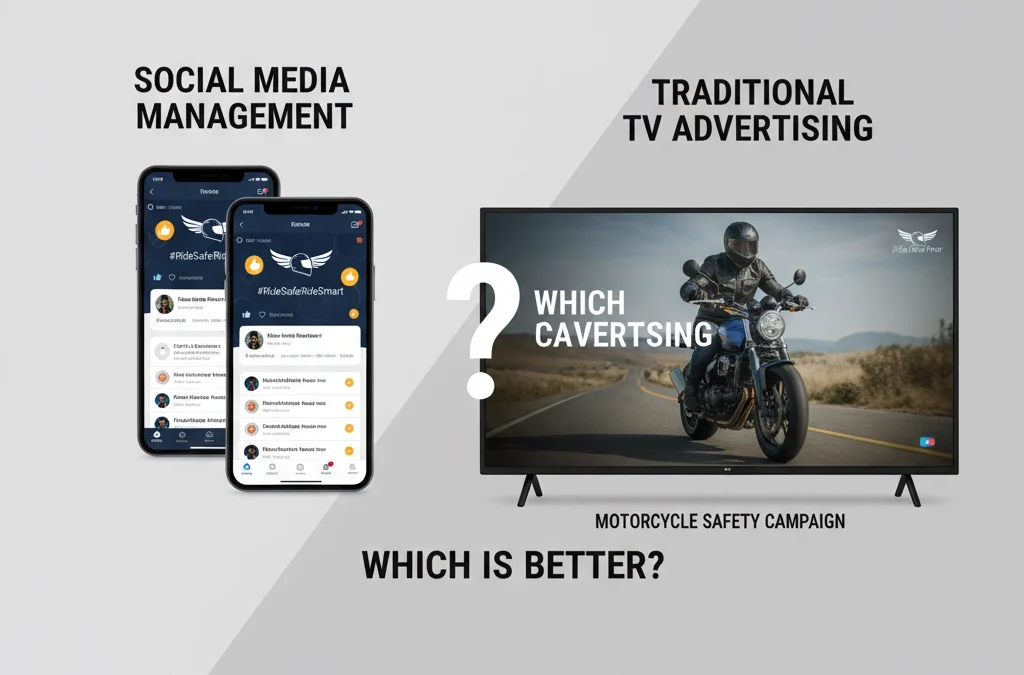Neither social media management nor traditional TV advertising alone creates optimal results for motorcycle safety campaigns. Research shows social media campaigns are only partially effective without complementary interventions, while TV advertising proves ineffective without enforcement support. The most successful motorcycle safety campaigns combine both channels with enforcement activities, leveraging social media's targeted reach among younger riders and TV's broad audience penetration.
The Modern Challenge of Motorcycle Safety Marketing
Every year, motorcycle safety organizations face a critical decision: where should they invest their limited marketing budgets to save lives? With motorcycle fatalities remaining stubbornly high despite decades of awareness campaigns, the choice between social media management and traditional TV advertising has never been more consequential.
The answer isn't as straightforward as choosing one over the other. Recent studies reveal that standalone approaches consistently underperform, while integrated strategies combining multiple channels with enforcement activities demonstrate remarkable success in changing rider behavior and reducing accidents.
Social Media Management: The Targeted Approach
Precision Targeting and Engagement
Social media platforms excel at reaching specific demographics with laser-focused precision. Facebook and YouTube allow motorcycle safety campaigns to segment audiences based on riding experience, bike type, age, and behavioral patterns. This targeted approach proves especially effective among younger riders, with research showing 62% of respondents under 24 reporting behavior changes after exposure to social media safety campaigns.
The interactive nature of social media creates opportunities traditional advertising cannot match. Riders share safety content, ask questions about gear recommendations, and build communities around responsible riding practices. When motorcycle influencers partner with safety organizations, their authentic storytelling resonates deeply with engaged audiences who trust their expertise.

Real-Time Adaptability
Unlike traditional media, social media campaigns adapt instantly to emerging trends or seasonal safety concerns. Campaign managers can adjust messaging based on weather conditions, upcoming riding events, or breaking safety research. This agility allows safety organizations to remain relevant and responsive to their community's immediate needs.
Cost Effectiveness
Social media advertising requires significantly lower initial investments compared to television production and airtime costs. Organizations can test multiple message variations, optimize performance based on engagement metrics, and scale successful campaigns within existing budget constraints.
The Limitations
However, social media management faces significant challenges in motorcycle safety campaigns. Research confirms these campaigns alone are "partially effective" and heavily context-dependent. The platform's targeting algorithms primarily expose content to users already interested in motorcycles, creating an echo chamber effect that struggles to reach non-riders who need awareness about sharing roads safely.
Additionally, the crowded social media landscape means safety messages compete with entertainment content for attention spans. Even well-crafted safety content can get lost among the thousands of posts users encounter daily.
Traditional TV Advertising: The Broad Impact Strategy
Unmatched Reach and Emotional Storytelling
Television advertising delivers unparalleled audience reach across all demographic groups simultaneously. Australia's Transport Accident Commission achieved 97% awareness among male drivers and 95% among all drivers through their television-focused motorcycle safety campaign. This broad penetration ensures critical safety messages reach both motorcyclists and the motorists who share roads with them.
Television's visual and auditory storytelling capabilities create powerful emotional connections that static or text-based content cannot achieve. The medium excels at conveying the serious consequences of unsafe riding behavior through compelling narratives that stick in viewers' memories long after the commercial ends.
Credibility and Authority
Television advertising carries inherent credibility and authority that social media posts often lack. When motorcycle safety messages appear alongside trusted news programs or popular entertainment content, they benefit from the medium's established reputation for delivering important information.

The Challenges
Traditional TV advertising faces mounting obstacles in today's media landscape. Production costs remain high, viewership continues declining due to cord-cutting trends, and targeting capabilities pale compared to digital alternatives. Most critically for safety campaigns, research shows television advertising alone proves "not effective" without accompanying enforcement or complementary interventions.
The one-way communication model prevents viewer engagement, feedback, or community building around safety practices. Once a commercial airs, campaign managers cannot adjust messaging based on audience response or emerging safety concerns.
Head-to-Head Comparison
| Aspect | Social Media Management | Traditional TV Advertising |
|---|---|---|
| Target Precision | Highly specific demographics and interests | Broad demographic reach by time slot |
| Cost Structure | Lower entry costs, scalable investment | High production and airtime expenses |
| Audience Engagement | Interactive, shareable, community-building | One-way communication |
| Young Adult Reach | 62% behavior change reported | Effective but less targeted |
| Non-Rider Awareness | Limited effectiveness | Superior broad market penetration |
| Message Adaptation | Real-time adjustments possible | Expensive and time-consuming changes |
| Standalone Effectiveness | Partially effective (context-dependent) | Not effective without enforcement |
| Emotional Impact | Variable, depends on content format | Strong narrative and visual storytelling |
The Winning Strategy: Integrated Multi-Channel Campaigns
The evidence overwhelmingly supports combining social media management with traditional TV advertising plus enforcement activities. This integrated approach saved an estimated 9,093 lives across several countries between 2010 and 2018, demonstrating the power of coordinated multi-channel motorcycle safety campaigns.
An effective integration strategy allocates TV resources for broad awareness and emotional storytelling while using social media for targeted safety education, community engagement, and real-time trend responses. Radio and outdoor advertising fill frequency gaps, ensuring consistent message exposure across multiple touchpoints.
Strategic Recommendations by Campaign Goals
For Young Rider-Focused Campaigns
Lead with social media platforms, particularly Facebook, YouTube, and Instagram. Partner with respected motorcycle influencers for authentic safety messaging. Supplement with targeted TV placements during programming popular with younger demographics. This approach maximizes engagement among the riders most likely to take risks while building safety-focused online communities.
For Comprehensive Motorist Awareness
Prioritize television advertising combined with billboard and radio campaigns to reach non-riding motorists who need awareness about motorcycle presence and vulnerability. Social media serves as a secondary channel for younger motorists while reinforcing safety messages among riders themselves.
For Budget-Conscious Organizations
Focus resources on social media campaigns paired with local enforcement activities. This combination has proven effective across multiple international studies while requiring lower initial investments. Add TV advertising only when budgets expand, concentrating on high-impact messaging during peak riding seasons.
For Maximum Impact Campaigns
Deploy comprehensive integrated strategies using all available channels simultaneously. Television creates broad awareness and emotional impact, social media enables targeted engagement and community building, while enforcement activities provide credibility and behavior change motivation.
The motorcycle safety landscape demands sophisticated, multi-channel approaches that recognize both the strengths and limitations of individual advertising mediums. Organizations that combine social media management's targeting precision with television's broad reach, supported by enforcement activities, create the most effective campaigns for saving lives and promoting safer riding practices.
Ready to revolutionize your motorcycle safety campaign with integrated advertising strategies? Visit Ride Fear Free or call our AI Receptionist at +1 (970) 693-4854 to discuss your campaign goals with Dan Kost, CEO. Connect with Dan on LinkedIn for insights on effective safety marketing strategies.
Share this post:
#MotorcycleSafety #AdvertisingStrategy #SocialMediaMarketing #TVAdvertising #SafetyCampaigns #DigitalMarketing #TraditionalMedia #Motivation #Branding #Strategy #Marketing #AdvertisingAndMarketing #Innovation #Sports

